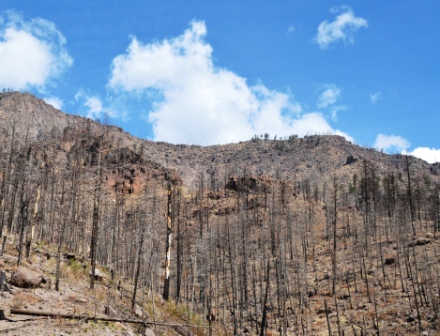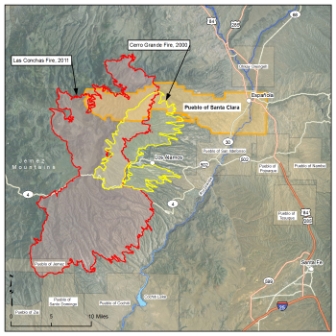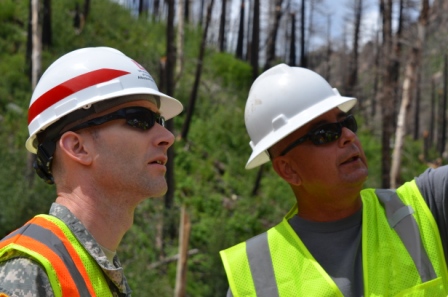"The partnership between USACE and the Santa Clara Pueblo is a fine example of why the Albuquerque District has the strongest Tribal Program in South Pacific Division. Flood Risk Management in the Santa Clara tribal area is incredibly important for the future of the Pueblo” ~ Brig. Gen. Mark Toy, commander, South Pacific Division, U.S. Army Corps of Engineers, following a recent visit with Santa Clara Pueblo leadership.
Building relationships is one of the U.S. Army Corps of Engineers’ main focus areas. True relationships are those in which both parties benefit. The Corps of Engineers, nation- and world-wide, strives to increase the mutual benefit between all its stakeholders and partners. Such is the relationship between the Albuquerque District Corps of Engineers (USACE) and the people of the Santa Clara Pueblo in northern New Mexico.
The Albuquerque District began building a relationship with Santa Clara Pueblo in the late 1990s. However, it began in earnest following the Cerro Grande Fire in 2000. The fire, which began as a controlled burn in Bandelier National Monument, quickly spread throughout the Jemez Mountains. It was, by far, the largest wildfire the state had ever seen up to that time. The fire burned approximately 43,000 acres, and took two months to extinguish.
 Santa Clara Pueblo was one downstream community that had a significant amount of fire damage. So much had been burned, that the entire village of Santa Clara was vulnerable to post-fire flooding. The Pueblo requested a consultation from the District Tribal Liaison, anthropologist Ron Kneebone, Ph.D., regarding salvaging their ceremonial land. USACE was tasked by the Burned Area Emergency Response (BAER) Team, along with many other federal and state agencies, to assist in implementing projects to mitigate post-fire effects, primarily flooding. While that was underway, USACE was tasked by the Federal Emergency Management Agency (FEMA), along with other federal and state agencies, to assist in implementing projects to mitigate post-fire effects. As FEMA’s planning and operating agent for Emergency Support, Public Works and Engineering, the USACE jumped into action. Together, USACE, the Tribe and FEMA initiated flood protection measures. USACE constructed several flood mitigation structures protecting the city of Los Alamos, Los Alamos National Laboratories, and the Pueblos of San Ildefonso and Santa Clara.
Santa Clara Pueblo was one downstream community that had a significant amount of fire damage. So much had been burned, that the entire village of Santa Clara was vulnerable to post-fire flooding. The Pueblo requested a consultation from the District Tribal Liaison, anthropologist Ron Kneebone, Ph.D., regarding salvaging their ceremonial land. USACE was tasked by the Burned Area Emergency Response (BAER) Team, along with many other federal and state agencies, to assist in implementing projects to mitigate post-fire effects, primarily flooding. While that was underway, USACE was tasked by the Federal Emergency Management Agency (FEMA), along with other federal and state agencies, to assist in implementing projects to mitigate post-fire effects. As FEMA’s planning and operating agent for Emergency Support, Public Works and Engineering, the USACE jumped into action. Together, USACE, the Tribe and FEMA initiated flood protection measures. USACE constructed several flood mitigation structures protecting the city of Los Alamos, Los Alamos National Laboratories, and the Pueblos of San Ildefonso and Santa Clara.
As a result of the close coordination between the Pueblo and the Corps during the Cerro Grande Fire, Santa Clara Pueblo leaders and staff learned about other opportunities and programs the Corps had to offer. This proved to be beneficial for the Corps, Santa Clara Pueblo, and other Pueblos along the Rio Grande.
In 2005, the Pueblos of Santa Clara, San Ildefonso and Ohkay Owingeh, three tribes on the Rio Grande, assumed leadership of the Española Valley, Rio Grande and Tributaries, Feasibility Study. This was a multi-purpose planning project to identify ecosystem restoration, flood risk management and incidental recreation alternatives on the Rio Grande through these Tribal lands.
Consultation with Santa Clara Pueblo continued on many levels. Corps and Santa Clara leaders began to meet regularly. Dr. Kneebone, USACE technical personnel, and district leaders were invited to attend tribal council meetings in order to explain the various Corps programs which could assist the Pueblo with further fire/flood mitigation. Being invited to attend Tribal Council meetings, where tribal leaders meet to discuss important matters, is a sacred request – and one not taken lightly by Corps personnel. It was an honor to be asked, and a cultural and significant partnership milestone between the partners.
In turn, Santa Clara Pueblo experts continued enhancing their skills, knowledge, abilities and capabilities in areas such as project management, hydrology, environmental issues and disaster management. In fact, they became experts in understanding many of the Corps programs.
In 2009, Santa Clara Pueblo initiated a request for watershed planning assistance for all the community’s Tribal lands. Ironically, in 2011, as negotiations were being finalized for this watershed study, the Las Conchas Wildfire occurred.
On June 26, 2011, ferocious winds kicked up throughout mountains and plains of New Mexico. Within hours, a downed power line started the Las Conchas Wildfire. In its first twelve hours burning, at the rate of 1 acre per second in some areas, the fire surpassed the total amount of the burn area of the Cerro Grande Fire. Exacerbated by the region’s persistent drought, approximately 156,000 acres of forest had been burned and literally destroyed, before the fire was brought under control over two months later. The wildfire fire burned so hot, and so severely, that all trees, plants and anything in the fire’s path was consumed. Photos taken during that time show nothing left but ash – like a huge ashtray. Like a blowtorch, the fire reburned forested areas that had previously burned in the Cerro Grande Fire. Nothing in its path was spared.
Almost 50 percent of the watershed above Santa Clara Pueblo was damaged. Fully aware of what the fire’s aftermath would bring, and relying on a decade of experience in working with USACE, the Pueblo contacted the Albuquerque District for assistance on the first day of the fire and the Corps responded.
 Operating under Public Law 84-99, the District’s Readiness and Contingency Operations Section (RCO), USACE began providing immediate technical assistance by providing a flooding vulnerability assessment for the community, several thousand sandbags, and training in the construction of improvised flood protection facilities.
Operating under Public Law 84-99, the District’s Readiness and Contingency Operations Section (RCO), USACE began providing immediate technical assistance by providing a flooding vulnerability assessment for the community, several thousand sandbags, and training in the construction of improvised flood protection facilities.
Then, as the 2011 New Mexico monsoon season loomed closer, and the extent of damage done to the watershed became more obvious, USACE support to the Tribe intensified. A vast amount of soil within the burn scar area had become hydrophobic, meaning that even when miniscule amounts of water hit the ground, nothing was absorbed. This hydrologic effect meant that, when monsoon season did arrive, runoff would be 10 times greater than only days before. Within these few months, the entire landscape had changed from the fire that had so ravaged the land.
USACE personnel developed a Technical Assistance Report for Santa Clara Pueblo. This report documented the newly-altered hydraulics, and associated increased flood risk, of the fire damaged watershed. The Corps then identified several measures to mitigate that risk, and estimates of the resources needed to implement those measures. The Tribe was later able to use this document as justification for its applications to other federal and state agencies for disaster assistance.
Less than a month after the fire ceased, the rains began to fall. The first flooding of the monsoon season was caused by only ¼ inch rain. What began as 50 cubic feet per second (cfs) became 5,000 cfs when it arrived at door of the pueblo. (See the video of the flood at: https://www.youtube.com/user/spausace).
Within days the District was providing direct assistance to the Tribe in its flood fight. The Corps performed a Technical Analysis of the damaged area, or burn scar. Corps personnel provided expertise and instruction as the Tribe began building temporary levees, clearing previous damage and obstructions, and holding sandbag training in hopes of preventing some of the damage that the ferocious floods would bring. Other help came from the surrounding area: 1,000 neighbors from the non-Indian community arrived at the pueblo to help with sandbagging. Corps personnel put their lives on the line fighting right next to tribal people. The district also sent heavy equipment and operators to flood fight. Several Corps employees were almost washed away in the torrent of the flash flood, and had to be rescued via helicopter from the Air National Guard.
 With the Corps’ assessment in hand, FEMA determined that potential impacts done by the fire put the Santa Clara Pueblo, and other areas within and around the burn scar, at a high flood risk.
With the Corps’ assessment in hand, FEMA determined that potential impacts done by the fire put the Santa Clara Pueblo, and other areas within and around the burn scar, at a high flood risk.
At the time of the Las Conchas Fire, and the follow-up flooding, the Santa Clara Pueblo was on the verge of stabilizing their land, so much so that there was much discussion about restoring their lands to its original landscape. Discussion had centered on the Corps and the Tribe signing a Section 203 Watershed Study together. Because of the severe and extensive damage to the land, the scope of the Section 203 partnership agreement was changed to adjust to the new needs of the Tribe. In September 2011, Santa Clara Pueblo and the Albuquerque District did sign a Section 203 Tribal Partnership Agreement Program Watershed Study Assessment; however there were many added changes to the original scope.
The relationship has been a work in progress and has built into a trusting relationship throughout the years. It has now become a relationship, not of consultation, but of partnership.
On his recent trip to the Albuquerque District, Brig. Gen. Toy had the opportunity to meet with Michael Chavarria, governor, Santa Clara Pueblo, and to view the damaged land. Toy noted, “Our Corps team is working hand-in-hand with Pueblo leaders to reduce the imminent risk of major flooding, caused by erosion, after the wildfire in 2011. The District is developing evacuation plans, improving stream channel capacity, and armoring embankments. It is important work and we are proud to assist.”
 “It has been a tremendous honor to work with the Corps of Engineers,” said Governor Chavarria. “They came and worked with the Tribe on a personal, face-to-face basis. The Corps has really listened to us, and to the needs of our People,” he said. “In order to help fulfill our needs, the Corps had to ‘think differently’ to provide solutions for us.”
“It has been a tremendous honor to work with the Corps of Engineers,” said Governor Chavarria. “They came and worked with the Tribe on a personal, face-to-face basis. The Corps has really listened to us, and to the needs of our People,” he said. “In order to help fulfill our needs, the Corps had to ‘think differently’ to provide solutions for us.”
"This was a great opportunity to meet with Governor Chavarria, and his team,” said Lt. Col. Dagon, Albuquerque District commander. “Traveling through the upper canyon of Santa Clara has given both BG Toy and I the opportunity to fully understand the current and planned mitigation effort provided by our district,” he said.
This partnership has been extremely beneficial, for USACE and all of its customers. “USACE is better at delivering water resource services to the Nation because we are better at delivering these services to tribes,” said Kneebone.
Most recently, the Santa Clara Pueblo and USACE have initiated a Continuing Authorities Program Section 205 Small Flood Risk Management project.
“As we face the future together, we stand shoulder to shoulder with the Tribe,” said Kneebone. “Together we will continue to help stabilize the canyon over the next decade, and assist the people of Santa Clara to feel safe in their homes.”
"I am looking forward to continue working with the people of Santa Clara Pueblo, and to further strengthening the robust relationship that already exists," said Dagon.
“I very much appreciate the hospitality shown to me by our partners,” said Brig. Gen. Toy. “Working together, we will continue ‘Building Strong and Taking Care of People’ in the Santa Clara Pueblo.”